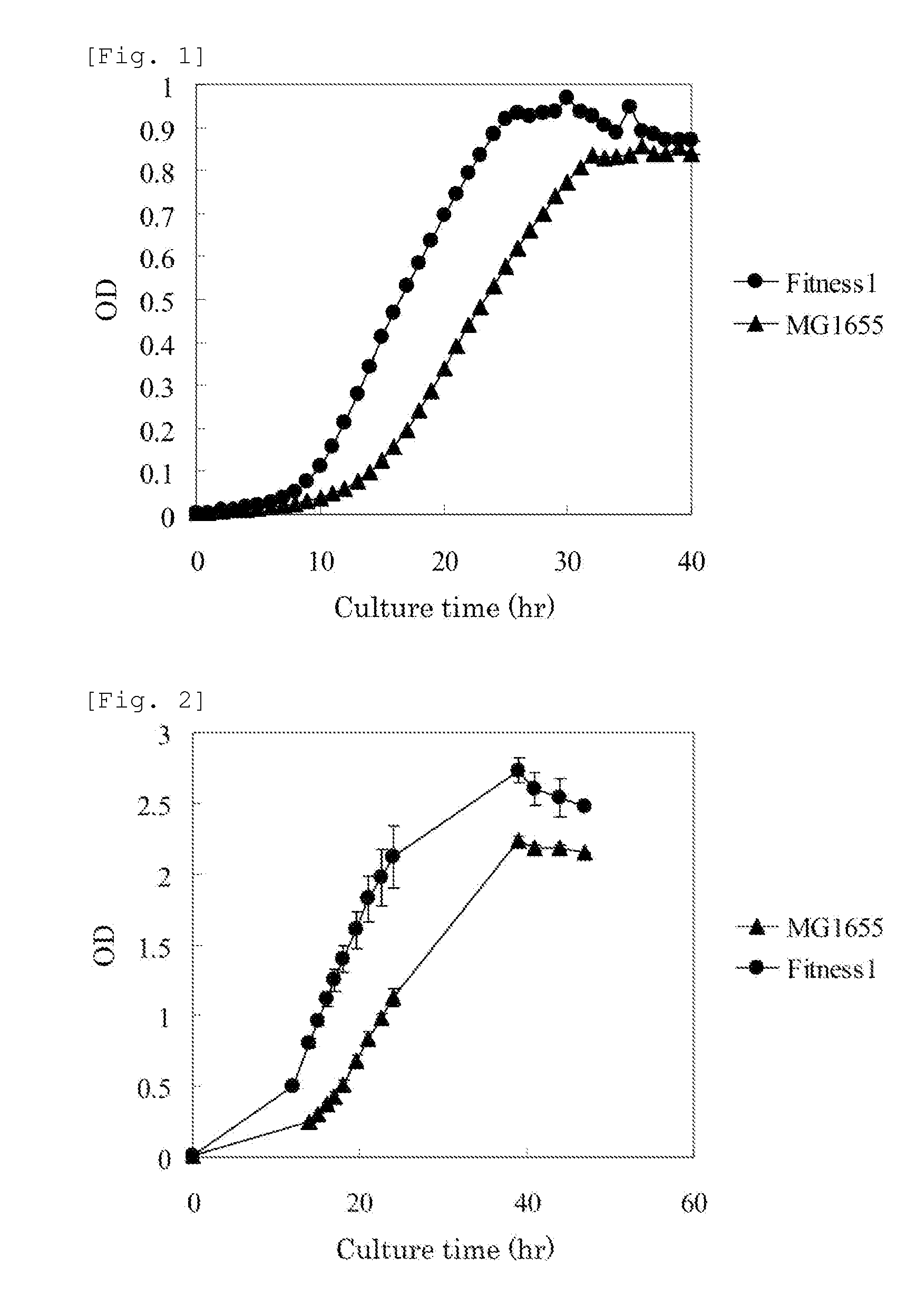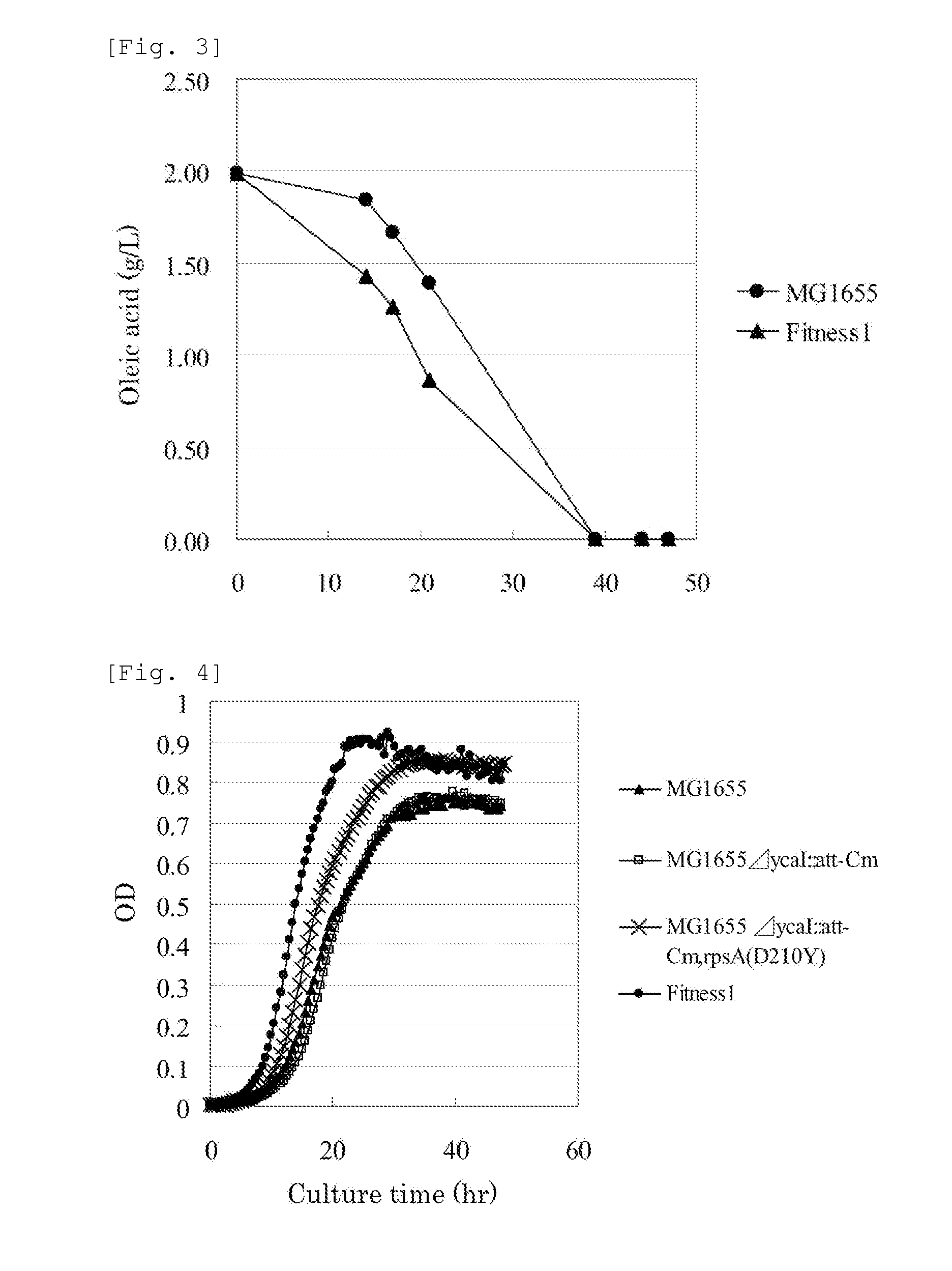MUTANT rpsA GENE AND METHOD FOR PRODUCING L-AMINO ACID
a technology of rpsa gene and rpsa gene, which is applied in the field of bacterium-based lamino acid production methods, can solve problems such as l-amino acid productivity, and achieve the effect of improving the growth rate of bacterium and efficiently producing
- Summary
- Abstract
- Description
- Claims
- Application Information
AI Technical Summary
Benefits of technology
Problems solved by technology
Method used
Image
Examples
example 1
Acquisition of Strain Showing Improved Fatty Acid-Utilizing Ability
[0232]A strain was obtained showing improved fatty acid-utilizing ability by using the MG1655 (ATCC 47076) derived from the Escherichia coli wild-type strain, K12 strain, as a parent strain. The MG1655 strain is available from American Type Culture Collection (address: P.O. Box 1549, Manassas, Va. 20108, United States of America).
[0233]The MG1655 strain was cultured for 24 hours as static culture on the M9 sodium oleate agar medium (adjusted to pH 7.0 with HCl). The grown cells were scraped off, suspended in a 0.85% NaCl aqueous solution, and inoculated into 5 mL of the M9 sodium oleate liquid medium in an L-shaped test tube at a turbidity of 0.00625 measured at a wavelength of 600 nm. After the culture was performed at 37° C. and 70 rpm for 20 hours by using a constant-temperature shaking incubator TN-2612 (Advantech), 10 μL of the culture broth was transferred to 5 mL of the M9 sodium oleate liquid medium in an L-s...
example 2
Culture of Microorganism Showing Improved Fatty Acid-Utilizing Ability
[0238]The glycerol stock of Fitness 1 strain was cultured for 24 hours as static culture on the M9 sodium oleate agar medium (adjusted to pH 7.0 with HCl). The grown cells were scraped off, suspended in a 0.85% NaCl aqueous solution, and inoculated into 5 mL of the M9 sodium oleate liquid medium in an L-shaped test tube at a turbidity of 0.005 measured at a wavelength of 600 nm. The culture was performed at 37° C. and 70 rpm for 20 hours by using a constant-temperature shaking incubator TN-2612 (Advantech), and as a result, the Fitness 1 strain showed significantly improved growth compared with the MG1655 strain cultured under the same condition (FIG. 1).
[0239]Furthermore, the glycerol stock of Fitness 1 strain was cultured for 24 hours as static culture on the M9 sodium oleate agar medium (adjusted to pH 7.0 with HCl). The cells on the agar medium were scraped off, suspended in a 0.85% NaCl aqueous solution, and ...
example 3
Identification of Mutation in Fitness 1 Strain
[0242]Mutation sites on the chromosome of the Fitness 1 strain were searched for by the CGS method described by Herring et al. (Herring, C. D. et al., 2006, Nat. Genet., 38:1406-1412). As a result, it was found that, in the Fitness 1 strain, G at position 628 in the nucleotide sequence of the rpsA gene of the MG1655 strain (SEQ ID NO: 1) was mutated to T.
[0243]It became clear that the aspartic acid residue at position 210 in the amino acid sequence of the RpsA protein (SEQ ID NO: 2) encoded by the rpsA gene of the MG1655 strain was replaced with a tyrosine residue due to this mutation. This mutation was designated as RpsA (D210Y) mutation.
[0244]The nucleotide sequence of the mutant rpsA gene of the Fitness 1 strain, and the amino acid sequence of the mutant RpsA encoded by this gene are shown in SEQ ID NOS: 3 and 4, respectively.
[0245]Sequences around position 210 of the amino acid sequences derived from rpsA gene homologues of various o...
PUM
| Property | Measurement | Unit |
|---|---|---|
| temperature | aaaaa | aaaaa |
| temperature | aaaaa | aaaaa |
| temperature | aaaaa | aaaaa |
Abstract
Description
Claims
Application Information
 Login to View More
Login to View More - R&D
- Intellectual Property
- Life Sciences
- Materials
- Tech Scout
- Unparalleled Data Quality
- Higher Quality Content
- 60% Fewer Hallucinations
Browse by: Latest US Patents, China's latest patents, Technical Efficacy Thesaurus, Application Domain, Technology Topic, Popular Technical Reports.
© 2025 PatSnap. All rights reserved.Legal|Privacy policy|Modern Slavery Act Transparency Statement|Sitemap|About US| Contact US: help@patsnap.com



